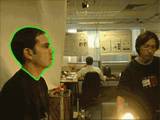
|
|
||||||||
Curved Surfaces
A more challenging problem than that of linear perspective is to recover information about curved surfaces from their profiles or silhouettes. Geometry is still relevant for interpreting the most commonly used cue which is the outline or profile observed. For instance, when we view a sculpture, it is common to walk around it and view it from many different angles to obtain visual information about its shape. Researchers in the Computer Vision group have developed a system for obtaining such information automatically with cameras. Unlike other systems no calibration of the camera or the image is required. An object can be rotated in front of a fixed camera, and its outline or contour can then be recorded. The contours extracted are represented by 'B splines' which are tracked and reconstructed to produce an approximate model.
 |
 |
| The left hand image shows the rotation and tracking of a person's head (click the image to animate it), while the right hand image shows the reconstructed 3D model. | |
There is a lot of interest in this process from the computer games and graphics industry, as it will be possible to create a three dimensional image of the game player, enabling that image to be used in the game. A more serious application is for the digital archiving of medical organs. Apparently surgeons would find it useful to keep a three dimensional and textural record of organs they have used for transplant, for instance. Such models could also be used for the purposes of measurement.